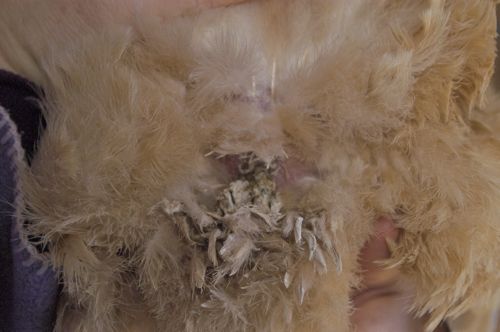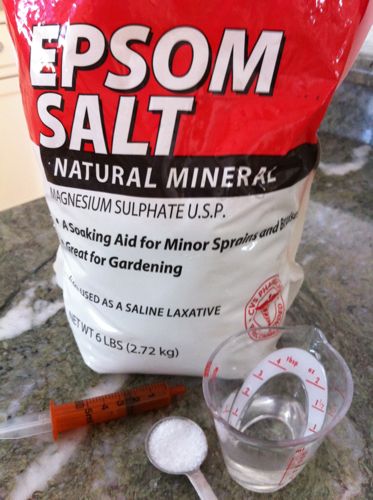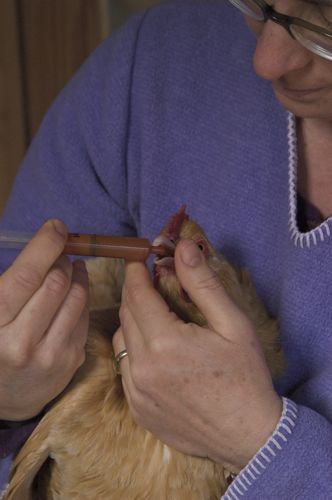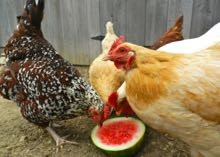UPDATE: For a detailed description of how to use an epsom salt soak to (possibly) save an ailing hen, read my FAQ: The Spa Treatment.
Buffy was given to me five years ago. She was in a flock that was ruled by a killer hen. Each day that hen pecked another hen to death. She targeted the head. Buffy was next in line. She came here with a bald spot near her comb. It’s still there. Obviously, Buffy was under stress. I wasn’t surprised to note a messy vent runny with diarrhea. Fear can give the runs to anyone, even a chicken. In the years that I’ve had this peaceful chicken, that diarrhea comes and goes. Stress can cause real disease. My best guess is that it’s a yeast infection, possibly “vent gleet” or related to it.
It’s stinky. It freezes when the temperatures plummet. At the least it’s uncomfortable for Buffy. At the worst it’s a symptom of a problem that needs to be remedied. Yeast is something that is very hard to get rid of. Managing it and minimizing the outbreak is the goal.
Like so much of chicken care, there’s only a few items in the medicine kit, but they work on a multitude of issues. That’s good, because diagnosing illness really is a matter of “best guess.” In this case, I use epsom salts.
Epsom salt is a naturally occurring mineral, a combination of magnesium and sulfate. It’s soothing on the skin, and so is the choice for soaking baths if a hen has a dermatological issue. Epsom salt is also used internally. It detoxifies toxins, so if your hen has ingested a dangerous plant, or consumed botulism, or gotten into a poison, an epsom salt drench is the cure. It acts as a laxative, so if your hen’s system needs flushing, or if her crop is impacted or the digestive process seems blocked, this will gently move things along. It also controls yeast infections. It’s a general cure-all, so if you’re faced with a hen that seems weak in the legs, has a sudden loss of vigor, seems sick without having respiratory symptoms, epsom salt might help. It can’t hurt.
Over the last week I’ve noticed Buffy’s vent looking messier and messier; otherwise she’s behaving normally. It’s time for an epsom salt drench.
If, for some reason, you want to treat the entire flock, you can put epsom salt in their drinking water – use 1 teaspoon per cup. Leave it out for one day. (This isn’t something to feed on a regular basis.) But, since I only want to douse Buffy, I dilute 1 teaspoon of epsom salt in 1 ounce of lukewarm water. I have a syringe at hand. (This is a plastic syringe available at your local pharmacy.)
Hold the hen so that she is comfortable and her wings are kept at her side. Open the beak with one hand and squirt the liquid in her throat, a little bit at a time so that she can swallow. Don’t shoot it down her open gullet at full-force, or it could get into her lungs. Let her close her beak and swallow. Repeat. If some dribbles out, don’t worry. Wear clothes you don’t care about – she’s bound to shake her head and spray you. Besides, the reason you’re treating the hen is because of that stinky butt…
Dose her with most of the epsom salt mixture. Repeat again in about twelve hours or the following day. That’s it! If your hen is seriously ill, douse two more times. But, if that dosage doesn’t improve things, more won’t be the answer.
I’ve used epsom salt, now and then, for Buffy’s messy vent. It always makes it better. I also used it when she mysteriously became paralyzed. That recovery took months, but recover she did. I believe that she got into a toxic plant and the epsom salt is what saved her.
Have you used epsom salt? What’s your story?




Oh, bless epsom salt! yes, I’ve used it for leg mites. I’ve tried the petroleum jelly cure, but it acts like flypaper for shavings and dirt, so instead I Mix a solution of one teaspoon epsom salt, one quarter cup rubbing alcohol, to 1 1/2 cups warm water. Put this into a spray bottle. It is easy to spray the feet and legs when they are going up the ladder to the loft roost, but I keep the bottle handy in the coop and spray any foot that looks like it needs it. Won’t hurt, and prevents playing do-si-do with the claws and spurs of an alpha rooster! (epsom salt is also good for tomatoes :-}
Never used it, but I have always had it on hand because… well.. I don’t know. So thank you, Terry, for letting me know why I have this big container of Epsom Salt in the bathroom closet!
Terry,
What is vent gleet? I have a nervous hen that always has a messy vent and stinky poo(unlike my other girls). And she has very fluffy bloomers! I’ve trimmed off some of the clumps but until the weather gets warm I don’t dare try to bath her. I can pick her up but I doubt that she will ever be calm in a bath. I wondered how warm a chicken bath should be. I’ve seen your great UTube video but I’m not sure about temp. I will try the salt drench and hope that helps. She acts fine, tho. Thank you for your great advice.
You’ll know vent gleet when you smell it. It’s not just diarrhea – it’s a yeast infection so that there’s a runny mess coming out of the vent. Not contagious, thank goodness.
Thank you Terry! I’ve got a couple if not three hens that I think could use this treatment. Ever since I treated the flock with the antibiotic months ago I’ve noticed the smell and messy bottoms on a couple of them. Had no idea yeast was a chicken issue let alone Epsom salts to cure it! I’ve got a box of it on my shelf that the most I’ve ever used it for was to soak my feet, which doesn’t happen often enough, as the box is quite old and still half full. Glad to have another good use for it.
Hi Terry,
It’s amazing how I can read over all my books and do search after search, only to find just what I need to know on your site. Where do you find your information?
I’m in the process of starting a backyard chicken group. Your site will be first on my resource list!
Thank you,
Gail
Gail- I’ve had 15 years of experience. More importantly, I think is that I have a collection of chicken keeping materials from the 1940’s and before, when the “village hennery” was common and small flocks were the norm. Just yesterday, I read a 1949 book on “Diseases and Parasites of Poultry.” I also have a degree in animal science, so I filter what I read through a sensible, science-based eye. I’m glad my chicken obsession is helping others!
This is great information, Terry. Thank you. When I finally get my chickens, I will have learned SO much from you. I’d never heard of vent gleet before, but I’m prepared. Like Sharon, I have some for soaking my feet, too!
A couple of my hens in the last month have had really loose stool. Kinda odd dark! reddish brown in color. I will get some epson salt. They are happy and still laying all through winter. 7 eggs a day from 10 hens! I am just about a year into this backyard hen keeping and had them as a child. Never had hens lay like mine do in the winter. I really apprecaite all your incite. Thank you so so much!
Manure changes with the seasons. As long as it’s a solid pile, you’re probably okay. My hens have been eating snow, so that makes it looser. Your hens are young which is one reason they’re laying like that. Some breeds lay more than others. But, lucky you to have so many winter eggs!
Yes epsom salts, cod liver oil, Vick’s vapor rub, my grandmother couldn’t have survived without them. ;-)
Terry, I too have a degree in the animal related field. In your education to you have the “pleasure” of visiting factory farms?
Ken, not for school (I went to UNH, not exactly in the factory farm belt) but I did have a job that required me to go to slaughterhouses and to “cage-free” chicken farms. That’s why I’m so fussy about where the meat I buy comes from!
Amen Terry. I’m still fortunate that family members still raise a few steers and hogs. I buy my red meat from them.
Chicken and turkey on the other hand unfortunately comes from the store, can’t find a supply of pastured raised poultry around here except at Thanksgiving.
Terry,
Well your post is the only thing I have found that comes close to what is going on with my flock. I thought I would run it by you and see what you think. I have lost 9 birds so far. (I have a big flock started at 60 and I supply my local rural area with an egg CSA). I was at the vet today for them to dissect a bird that died today and they did not find anything abnormal in the dissection or the fecal test they did. The only thing abnormal was that the liver was soft and it has died from prolapse, which was led up to by what I call “poopy bottom”.
I found the suggestion that you can add epsom salt to their feed 1 lb to 15 lbs feed or do the water treatment like you said. I wonder if I should treat all the birds with the feed method and then treat the 9 who are showing symptoms with the epsom salt water treatment you write about.
I have been living with the mystery of birds dieing for over a month and I hoped the vet could help, so we sent the bird on to a lab to be tested to see what else may show up….
The birds have runny poop which is smelly and builds up on their bottoms and then after what seems like a long period of time they die of prolapse. It is horrible and I am feeling so helpless. The only thing that makes me suspicious this is not vent gleet is that it seem to be rampant in the flock, I have lost 9 birds and currently have 9 showing symptoms. Also what do you think adding apple cider vinegar to the water to be something to inhibit yeast growth for the flock that seems ok currently and follow up with the sick ones…
Sorry for the lengthy post but I gasped when I saw you page and am very hopeful that it may be an answer for me…..
Quick questions (and I’ll ponder this overnight) – did the vet run any blood tests? How old is this flock? Where are you? Once in awhile, I’ve heard of bizarre parasites in areas with unusually wet conditions. I’ve never heard of disease causing prolapse. Have they been checked for coccidia? The epsom salt can’t hurt. Do it while we ponder this and while you wait for the lab results.
I looked through all of my vintage poultry care books (from when pastured poultry was how everyone did it.) There is nothing about prolapse that follows diarrhea. Sometimes a flock of hens become vent pickers – especially when the bottoms are exposed and diseased. And that can lead to prolapse. Have you noticed a lot of feather/skin pecking?
Sometimes hens that are overweight, or young and laying very big eggs, tend to prolapse. Some strains are more susceptible to this.
If it is vent gleet, it could be so severe that they are straining to the point of prolapse.
Apple cider vinegar in the water is also a good idea.
Keep me informed! We can all learn from this difficult situation.
I am in far northern Wisconsin on Lake Superior, where winter is winter. As I am writing my vet just called and one of her techs who was not there yesterday came in the morning and they looked at the bird I left with them and she said that is coccidia for sure. She is calling me back with her recommendations on what to do for it. With you suggesting this option and then getting this call I am game to try to combat this like it is coccidia. My vet said it is liking that the prolapse is a secondary reaction to a drawn out case of coccidia. I have veered away from it being coccidia since my flock is 10 months old and were pastured and exposed to almost everything but I guess they did not develop enough immunity….
What are you recommendation for coccidia? I have read there are many different medications you can give but if you do not give the right one then it can cause more harm than good since there are so many different forms of coccidiosis.
I also keep my flock at an organic fed, no nasty stuff given flock (though I am not certified) so I wonder what this will mean for their eggs?
So glad to have found you to consult, thanks for being back in touch!
Very interesting! Yes, I thought the prolapse was a “red herring” to the real problem. I’m beginning to believe that farmers like you, doing it on a small scale, on pasture, have hens that at first can fight off disease, but then get symptoms later in life. On the factory farms, the hens are either over-medicated, or die as chicks. The books discuss illness in those terms, which is why the diagnosis today isn’t something you come across. Illness in older hens has a slower onset and the symptoms are not the same as what you see in chicks.
Coccidia is a nasty protozoa. I’d go with what your vet suggests, even if it’s not organic. And I’d give the pasture where that flock has been a rest. I’ve read that coccidia is killed by freezing – so that should happen where you are! But, it’s harbored in damp, especially bedding. I’d burn/dispose of the litter and not compost it. One of my old books suggests cleaning out the house and using lime. They also suggest astringent in the drinking water, so do add cider vinegar. Let me know what the vet suggests as treatment.
Well what the vet and I decided is the best way to treat the coccidia we are seeing with the chickens is to treat them with “corid” also known as amprolium in the water and since it interfers with metabolism of Thiamin (vit B1) we are adding Thiamine into the water too to make sure they do not get deficient in B1. The amprolium is most effective in treating coccidia (eimeria acervulina and tenella) and can work for (eimeria maxima). The three in () are the most prevelent of the 7 found in chickens…
I enjoyed reading the veterinary bible today with her.
We looked into using a sulfa drug but you have to remove and discard eggs for a period of time and they did not have any form at the vet that said it was appropriate for laying hens (only meat birds), sulfa works only against eimeria acervulina and maxima and not tenella. So I guess I am taking the risk of maybe not treating maxima since the amprolium is not as effective with that strain.
We shall see, I am going to begin adding it to their water tonight, it says to treat for 5 days and maybe more. Also I have seperated out some of worse looking (only by bottom appearance, they are spunky as ever) birds to my garage and tonight I am going to trim the icky feather, and wash them up and then treat their bottoms with perparation H. I am going to treat the sick looking ones and the rest currently of the flock in the main coop with the amprolium based on the vets recommendation.
I also plan to do a 2 month or so early spring cleaning of the coop most likely tomorrow and get them on new fresh bedding.
Well off to clean some chicken bottoms.
Thanks so much for you support and help, it has been a key to the success of the past two days. I will be back in touch to let you know how things shape out in the weeks to come.
take care and by the way I like your dust bath set up, I have a box with diatomaceous earth for the birds but I think I will add some ash too!
Here is a good link that has helped me figure out medicine routes
http://attra.ncat.org/attra-pub/coccidiosis.html
but the vet books did give more indepth info to help with final decision.
Thanks for keeping me in the loop! When your birds were chicks did you give them feed with a coccidiostat? If there’s a way to get sunlight into the coop, that will help with the disinfecting, although this is a tough time of year to do it – I don’t imagine your weather in Wisconsin is any better that it is here! Kudos to you for taking such good care of each individual hen. The reality is that in most commercial situations, it’d be more economical to cull the diseased birds.
Just before I read your post today I was out cleaning and was actually thinking about the question you asked. I realized that this past year I got my birds from a different hatchery than I ever have before and that I forgot to ask for them to be vaccinated and if you don’t ask they don’t do it.
So I have learned a big lesson in that I will never forget to have my birds vaccinated for coccidiosis when ordering chicks in the future.
The birds are in a high tunnel (or hoop house) for their winter coop and the sun does get in if it shines but from all that I have read it seems like getting things as dry as possible and keep a good layer of fresh litter on top is my best preventative. I can’t wait to get them out of there and into their mobile pasture coop.
Heading back out to the chickens.
Thanks for your support, also I noticed the chickens I currently have in the garage (who are getting individual care) seem just a bit better to me today!
Take care
epsom salts! would you have any idea if scaly leg mites could be controlled with the salts? or any other suggestions for these? I accidentally introduced them to my flock after I brought in a couple of hens to keep a sole surving hen from a dog-ravaged flock company until I could rebuild the flock….now 4 years later, mites still rear their ugly heads and I end up with re-occuring infestations, despite thorough cleaning, roost oiling, leg oiling, and dreaded semi-annual ivermectin doses (lesser of two evils?) mites could also be sourced from wild birds that frequent the snow free areas under the coop where the hens dustbathe.
just found your blog and love it. even if you have induced tremendous egg carrier envy from that pic of the vintage metal egg carrier.
Rebecca- I checked my poultry books and didn’t see anything about epsom salts for scaly leg mites. I’ve had success slathering the legs with vaseline – but I didn’t have a serious infestation. One book did suggest tea tree oil, sprayed on. (They also said to use DDT – that’s how old the book is!) I’m curious why you do ivermectin twice a year. I thought that it was best to rotate wormers. I fear you’re going to develop drug-resistant parasites. Perhaps you should have fecals done to confirm there’s an issue to attack. I have a yearly fecal done and have yet to have internal parasites on my property. Have you been giving them access to DE?
I fear that now that I have shown off that egg carrier that all my readers will be looking for them on eBay and I’ll never be able to get another :)
Terry,
I use ivermectin when I can’t get the scaly leg mites under control with vaseline or oil dipping – seems to be more of a problem in the winter. I don’t use it for worming, I apply a few drops to the skin for the leg mites. It seems drastic to me, too!
Am hoping to be able to be more diligent about daily leg greasing for the chickens, it is hard in the winter as it is always dark, I have a horrid schedule with very limited time, and I missed the early signs of problems this winter and had a full blown problem with two of the hens –
I did look for your carrier on ebay today, but no luck. Am always ending up with smashed eggs in my pockets.
Check out the May 18, 2010 blog post. My favorite daily egg basket is the one on the far left. Why don’t you try the tea tree oil to combat the mites? It just might work – and they’d smell good :)
Just stopping from the link you left on my blog. Thank you so much for this information. I will try it, and am hoping it will help with her messy bottom which looks quite a lot like Buffy’s does. Her skin is even red and irritated looking below her vent, probably from the extra moisture I am guessing. I put Neosporin on it (all we had at the time) but it didn’t seem to do anything. We have washed up her backside twice and I even trimmed the feathers up some the first time. Washing seems to help for a few days but it always gets noticeable again.